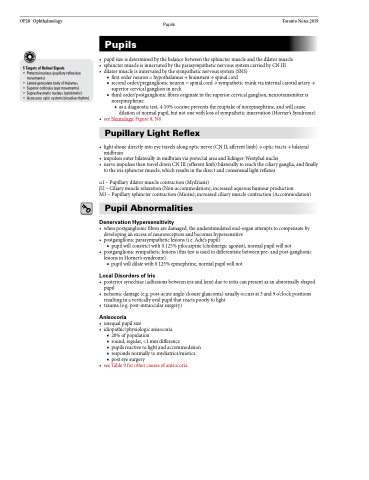Page 918 - TNFlipTest
P. 918
OP28 Ophthalmology
Pupils Toronto Notes 2019
5 Targets of Retinal Signals
• Pretectal nucleus (pupillary reflex/eye movements)
• Lateral geniculate body of thalamus
• Superior colliculus (eye movements)
• Suprachiasmatic nucleus (optokinetic)
• Accessory optic system (circadian rhythm)
• • •
•
•
• •
Pupils
pupilsizeisdeterminedbythebalancebetweenthesphinctermuscleandthedilatormuscle sphinctermuscleisinnervatedbytheparasympatheticnervoussystemcarriedbyCNIII dilatormuscleisinnervatedbythesympatheticnervoussystem(SNS)
■ first order neuron = hypothalamus → brainstem → spinal cord
■ second order/preganglionic neuron = spinal cord → sympathetic trunk via internal carotid artery →
superior cervical ganglion in neck
■ third order/postganglionic fibres originate in the superior cervical ganglion, neurotransmitter is
norepinephrine
◆ as a diagnostic test, 4-10% cocaine prevents the reuptake of norepinephrine, and will cause
dilation of normal pupil, but not one with loss of sympathetic innervation (Horner’s Syndrome)
seeNeurology,Figure8,N8
Pupillary Light Reflex
lightshonedirectlyintoeyetravelsalongopticnerve(CNII,afferentlimb)→optictracts→bilateral midbrain
impulsesenterbilaterallyinmidbrainviapretectalareaandEdinger-Westphalnuclei nerveimpulsesthentraveldownCNIII(efferentlimb)bilaterallytoreachtheciliaryganglia,andfinally to the iris sphincter muscle, which results in the direct and consensual light reflexes
α1 – Pupillary dilator muscle contraction (Mydriasis)
β2 – Ciliary muscle relaxation (Non-accommodation); increased aqueous humour production
M3 – Pupillary sphincter contraction (Miosis); increased ciliary muscle contraction (Accommodation)
Pupil Abnormalities
Denervation Hypersensitivity
• whenpostganglionicfibresaredamaged,theunderstimulatedend-organattemptstocompensateby developing an excess of neuroreceptors and becomes hypersensitive
• postganglionicparasympatheticlesions(i.e.Adie’spupil)
■ pupil will constrict with 0.125% pilocarpine (cholinergic agonist), normal pupil will not
• postganglionicsympatheticlesions(thistestisusedtodifferentiatebetweenpre-andpost-ganglionic lesions in Horner’s syndrome)
■ pupil will dilate with 0.125% epinephrine, normal pupil will not
Local Disorders of Iris
• posteriorsynechiae(adhesionsbetweenirisandlens)duetoiritiscanpresentasanabnormallyshaped pupil
• ischemicdamage(e.g.post-acuteangle-closureglaucoma)usuallyoccursat3and9o’clockpositions resulting in a vertically oval pupil that reacts poorly to light
• trauma(e.g.post-intraocularsurgery)
Anisocoria
• unequalpupilsize
• idiopathic/physiologicanisocoria
■ 20% of population
■ round, regular, <1 mm difference
■ pupils reactive to light and accommodation ■ responds normally to mydiatrics/miotics
■ post eye surgery
• seeTable9forothercausesofanisocoria


